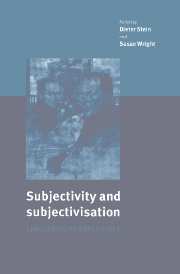Book contents
- Frontmatter
- Contents
- Contributors
- 1 Subjectivity and subjectivisation: an introduction
- 2 The epistemic weil
- 3 Subjectification in grammaticalisation
- 4 Emphatic and reflexive -self: expectations, viewpoint, and subjectivity
- 5 Subjectification and the development of the English perfect
- 6 Subjectification, syntax, and communication
- 7 Subjective meanings and the history of inversions in English
- 8 Subjectivity and experiential syntax
- 9 Non-anaphoric reflexives in free indirect style: expressing the subjectivity of the non-speaker
- 10 From empathetic deixis to empathetic narrative: stylisation and (de)subjectivisation as processes of language change
- Subject index
- Name index
4 - Emphatic and reflexive -self: expectations, viewpoint, and subjectivity
Published online by Cambridge University Press: 23 October 2009
- Frontmatter
- Contents
- Contributors
- 1 Subjectivity and subjectivisation: an introduction
- 2 The epistemic weil
- 3 Subjectification in grammaticalisation
- 4 Emphatic and reflexive -self: expectations, viewpoint, and subjectivity
- 5 Subjectification and the development of the English perfect
- 6 Subjectification, syntax, and communication
- 7 Subjective meanings and the history of inversions in English
- 8 Subjectivity and experiential syntax
- 9 Non-anaphoric reflexives in free indirect style: expressing the subjectivity of the non-speaker
- 10 From empathetic deixis to empathetic narrative: stylisation and (de)subjectivisation as processes of language change
- Subject index
- Name index
Summary
In this chapter I examine the semantics/pragmatics of the pronominal -self forms in English (himself, herself, themselves etc.; collectively referred to hereafter as -self). I describe two distinct kinds of meanings associated with -self, namely emphatic and reflexive -self, and show that each of these is associated with a closely related configuration involving a ‘viewpoint’. I then consider the viewpoint uses of -self in terms of the semantic parameter of subjectivity, in the sense of Langacker (1990), and relate it to other current notions of subjectivity.
In the following analysis, crucial reference is made to the notion of referential accessibility, a discourse concept developed by Ariel (1988, 1990) and very similar to the theoretical framework elaborated by Givón (1983) under the name ‘topic continuity’. Accessibility can be denned as the degree of ease with which a discourse referent can be identified or ‘picked out’ mentally via the use of a given referring element (with ‘referring’ understood in a broad sense including mental conceptions of any degree of specificity or definiteness). The fundamental claim of Accessibility Theory is that ‘referring expressions are no more than guidelines for retrievals’ (Ariel 1988:68), and thus the inherent semantics of each type of expression is the very processing procedure by which the referent is accessed. Referring expressions fall along a cline of degree of accessibility, from low accessibility signals like full, elaborated noun phrases, to high accessibility markers like pronouns and zero anaphora. The linguistic element of concern in this chapter, -self, is, as we will see, a marker of high accessibility.
- Type
- Chapter
- Information
- Subjectivity and SubjectivisationLinguistic Perspectives, pp. 55 - 82Publisher: Cambridge University PressPrint publication year: 1995
- 8
- Cited by



